Palestine-Israel Conflict: Retrospective
Why Jerusalem is So Important to Jews and Muslims
Why are Arabs Fighting for Jerusalem Against Jews?
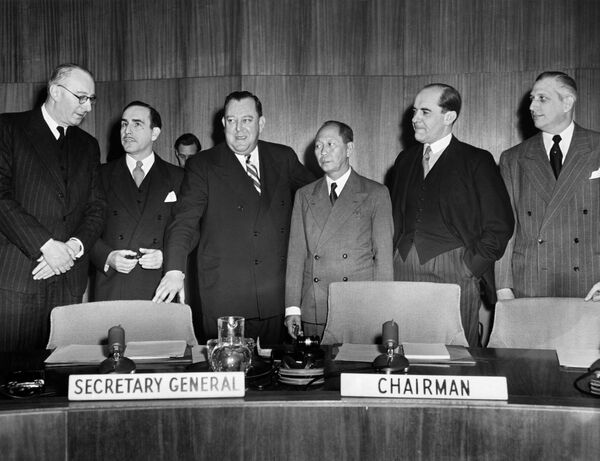
UN Secretary-General Trygve Lie (3rd left) and members of the UN Special Committee on Palestine (UNSCOP) meet at Lake Success on January 09, 1948 about the Israeli-Palestinian issue and to decide whether a UN security force will be needed to enforce the explosive Palestine partition plan, as new acts of violence have erupted in the Holy Land. From left to right: Dr. Karel Lisicky of Czechoslovakia, president of the commission, Raul Diaz de Medina of Bolivia, Trygve Lie, Vincente J. Francisco of the Philippines, Per Federspiel of Denmark and Reburto de La Guardia of Panama.
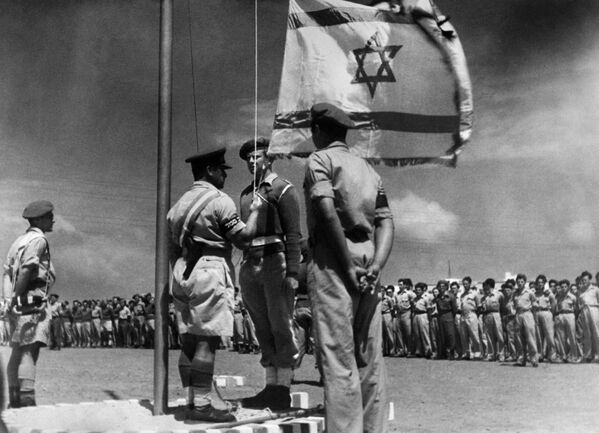
A picture released on June 8, 1948 shows an Israeli officer raising the National Flag for the first time during the celebration of the birth of the Israeli State after its proclamation, on May 14, 1948.
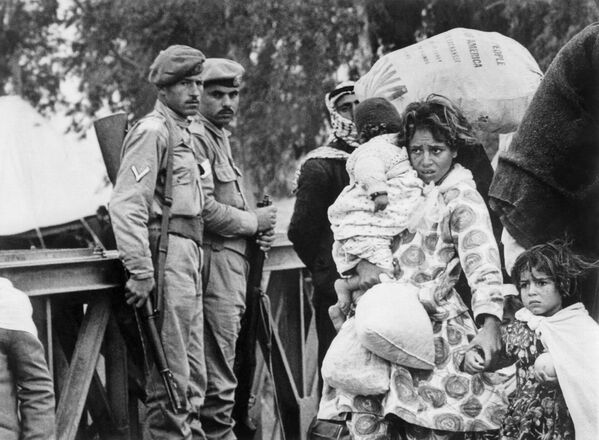
Three young Palestinian sisters from Gaza leave the West Bank occupied by Israeli troops to go to Jordan across the Jordan river January 23, 1968.
The movement of Palestinians from the West Bank of Gaza to Jordan in January 1968 was not a mass exodus or displacement like the Palestinian refugee crisis of 1948 but rather a result of complex political and military developments during that period.
In the late 1960s, the West Bank was under Israeli military occupation following the Six-Day War in 1967, and tensions in the region were escalating. The Palestine Liberation Organization (PLO) was gaining prominence as a resistance organization, and there were sporadic clashes between Palestinian militants and Israeli forces.
The specific events that prompted some Palestinians to flee to Jordan in early 1968 are related to the conflict and Israeli military actions in the West Bank and Gaza. These actions included military raids, curfews, and crackdowns on Palestinian activists, which led to a sense of insecurity and fear among some Palestinian communities.
As a result, some Palestinians may have chosen to leave the West Bank and Gaza for Jordan, seeking safety and refuge from the ongoing conflict and Israeli military operations. It's important to note that not all Palestinians in these territories left, and many remained in their homes despite the difficult circumstances.
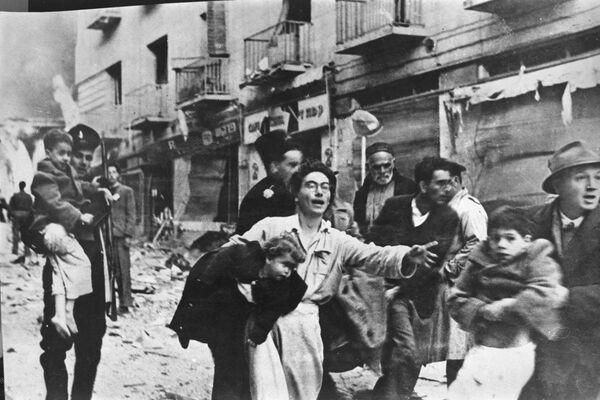
The picture dated 28 February 1947 shows the scene after a terror attack in Ben Yehuda Street in Jerusalem.
The terror attack on Ben Yehuda Street in Jerusalem on February 28, 1947, was a significant event during the period of conflict between Jewish and Arab communities in British Mandate Palestine.
The attack was carried out by a group of Jewish militants belonging to the Irgun, a Jewish paramilitary organization. The Irgun, led by Menachem Begin, was one of several groups involved in armed resistance against British colonial rule and Arab opposition.
The target of the attack was the civilian population of Jerusalem, particularly those in the vicinity of Ben Yehuda Street, which was a popular commercial and entertainment area. The attack aimed to create chaos and disrupt daily life.
The Irgun, along with other Jewish paramilitary groups, was advocating for the establishment of a Jewish state in Palestine. They believed that by targeting British forces and institutions, as well as Arab civilians, they could pressure the British to withdraw from Palestine and pave the way for Jewish statehood. The attack on Ben Yehuda Street was part of this broader campaign to achieve their political goals.
The Irgun placed explosives in suitcases at several locations on Ben Yehuda Street. The explosives detonated in the evening, causing a devastating explosion that resulted in significant loss of life and widespread destruction.
The explosion on Ben Yehuda Street resulted in the deaths of over 50 people, most of whom were civilians, and injured hundreds more. The attack caused extensive damage to buildings and businesses in the area, leaving a lasting impact on the city.
The 1947 attack on Ben Yehuda Street occurred in the context of increasing violence between Jewish and Arab communities as well as against British authorities. It was part of a broader pattern of bombings, assassinations, and other acts of violence that characterized this period, which eventually led to the British decision to withdraw from Palestine in 1948. This withdrawal paved the way for the declaration of the State of Israel and the outbreak of the First Arab-Israeli War.

This picture dated 1948 shows a Palestinian woman refugee and her child separated from their home by the Green Line after the 1948 war.
The Green Line was the armistice line established in 1949 at the end of the 1948 Arab-Israeli War, also known as the War of Independence. It played a significant role in shaping the geopolitical landscape of Israel and the Palestinian territories.
The Line became a result of armistice agreements negotiated between Israel and its neighboring Arab states, including Egypt, Jordan, Syria, and Lebanon. These agreements were brokered by the United Nations and were intended to bring a temporary halt to hostilities and create a demarcation line separating the warring parties.
The armistice agreements were signed between February and July 1949, effectively ending the major combat operations of the 1948 war. The Green Line was established during this period, and it marked the de facto borders between Israel and the neighboring Arab states at that time.
The Green Line was not a permanent border or an internationally recognized boundary. It was simply a demarcation line, often drawn on maps in green ink, to represent the position of Israeli and Arab forces at the time the armistice agreements were signed.
The Line divided the former British Mandate of Palestine into two main areas: Israel on one side and the West Bank (controlled by Jordan) and the Gaza Strip (controlled by Egypt) on the other. This division had a profound impact on the future of the Israeli-Palestinian conflict.
The border's line became a central point of reference in subsequent negotiations and discussions regarding the Israeli-Palestinian conflict. It played a role in defining the borders of Israel following its declaration of statehood in 1948 and was the starting point for discussions about the status of Palestinian territories in the years that followed.
Palestinians commemorate 14 May the 50th anniversary of the "Nakba" ['catastrophe', in Arabic) marking the creation of Israel and the exodus of 700 000 Palestinian refugees from their land.
The Green Line represents a physical reminder of the displacement and division caused by the 1948 war. It still exists in historical and political contexts, but is not a recognized international border.

An Israeli soldier watches Palestinian refugees crossing the war-wretched Allenby Bridge to reach the east bank of Jordan 22 June 1967. The June 1967 war was a stunning military victory for Israel, but the start of a political stalemate that continues to this day. During the Six-Day War Israel suffered around 700 fatalities, while estimates of the numbers of Arabs killed range from just over 11,000 to 21,000, with losing the Egyptians paying the heaviest tribute. Israel was left in control of the Sinai, the Gaza Strip, the West Bank and East Jerusalem, as well as the Golan Heights. Some 350,000 Palestinians fled the newly occupied regions to take up residence in neighboring states. Most of them have never been able to return, and are still living in refugee camps.

A British-made armored vehicle is abandoned among the rubble of the destroyed buildings in downtown Jerusalem July 7, 1948 during the first Jewish-Arab conflict, started in February 1948 before the proclamation of the state of Israel, May 14, 1948.
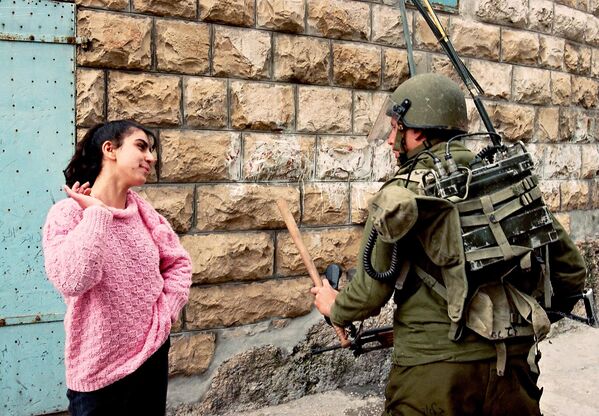
A Palestinian girl talks to an Israeli soldier on February 28, 1988, in Bet Sahur after the Israeli army had entered the village near Bethlehem following violent demonstration.
The Palestinian uprising, often referred to as the intifada, was a sustained period of Palestinian protests and resistance against Israeli occupation in the West Bank, Gaza Strip, and East Jerusalem. It began in December 1987 and continued until 1993 when the Oslo peace accords were signed.
The intifada was sparked by a combination of factors, including frustration with Israeli occupation, economic hardship, political grievances, and a desire for self-determination.
The intifada was characterized by a variety of forms of protest and resistance, including mass demonstrations, strikes, civil disobedience, and the use of stones as weapons. The term "war of stones" refers to the practice of Palestinian youths throwing stones at Israeli soldiers and military vehicles.
It was not uncommon during the intifada for Israeli forces to enter Palestinian towns and villages, like Bet Sahur, in response to protests, often resulting in clashes.
The intifada lasted for several years, during which time it had a profound impact on the Palestine-Israel conflict. It led to significant changes in the political landscape and eventually contributed to the initiation of peace talks.
The intifada continued until 1993 when the Oslo peace accords were signed between Israel and the PLO, and laid the groundwork for subsequent negotiations.

Two Israeli soldiers patrol a mostly deserted street in the city of Gaza, March 6, 1971, in the Israeli-occupied Gaza strip, taken from Egypt in the Six Day War. Israeli soldiers have dubbed the street "Grenade Alley" due to the number of incidents there.
After the Six-Day War (1967), Israel gained control over the Gaza Strip, which became part of the territories administered by Israel. This occupation led to various challenges and tensions between the Israeli military and the Palestinian population in Gaza.
During the period of Israeli occupation, Gaza witnessed a significant level of unrest, with tensions between the Palestinian population and Israeli military forces. This led to various forms of protests, clashes, and acts of violence.
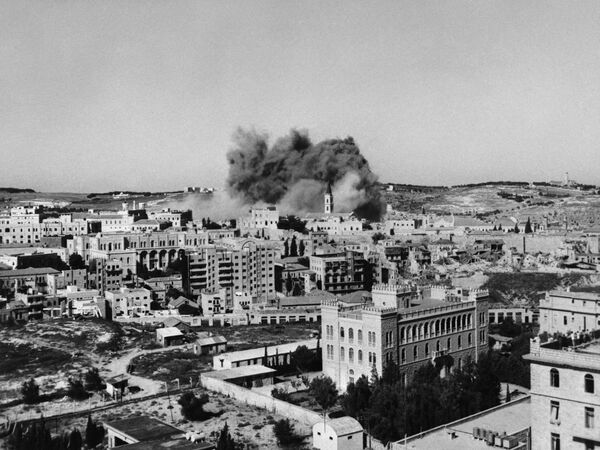
Smoke raises from the Old city of Jerusalem in August 1949, during the Arab-Israeli War.

An old Arab woman, caring little of the fortunes of the war in Palestine, sits in the dust of the industrial main street in the Negev coastal town of El Majdal, Nov. 13, 1948. She is one of 2,000 Arabs that remained after its Egyptian garrison retreated before Jewish occupation forces arrived. She remained because she had nowhere to go and no means to get there. El Majdal had a population of about 7,000.
The Egyptian troops were stationed in the town of El Majdal (now known as Ashkelon) in the Negev region during the 1948 Arab-Israeli War.
The Egyptian garrison was present in El Majdal as part of the broader Arab military intervention in the 1948 war. When the State of Israel was established in May 1948, neighboring Arab states, including Egypt, sent troops to support Palestinian Arabs and oppose the newly formed Israeli state. The Egyptian garrison in El Majdal was part of this military effort to protect Arab interests and to oppose Israeli forces in the region.

The house where 17-year-old Vadan Shaaban Ibrahim Nakusi lived is blown up by Israeli army sappers after he was accused of being the leader of a petrol bomb gang operating in the occupied West Bank on June 7, 1989.

An Israeli soldier, armed with a sten gun, picks her way through the shattered walls of Sulimans Way, in the old city of Jerusalem, Palestine, July 20, 1948, which forms a front line between the Arabs inside and Jewish forces outside the walls. Fierce fighting happened between the two forces following the expiry of a two-day truce.
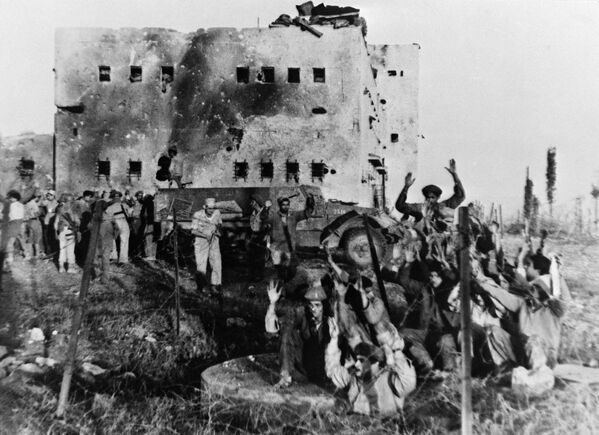
Egyptian soldiers leave the shelters where they had taken refuge on November 18, 1948 near Tel Aviv. Shortly after Israel's independence declaration and the beginning of the 1948 Arab–Israeli War, the Haganah was merged with other groups and reorganized into the official army of the state and became the core of the Israel Defense Forces (IDF).

A US-built Israeli tank churns dust in the desert in this photo taken in June 1967 on the Golan Heights. Thirty years after the six-day war, new revelations show that Israeli generals exerted considerable pressure to push their government to go into battle. The war was decided on during a meeting 02 June 1967 between the chief of staff and the Labor government of Levy Eshkol following the failure of diplomatic negotiations.
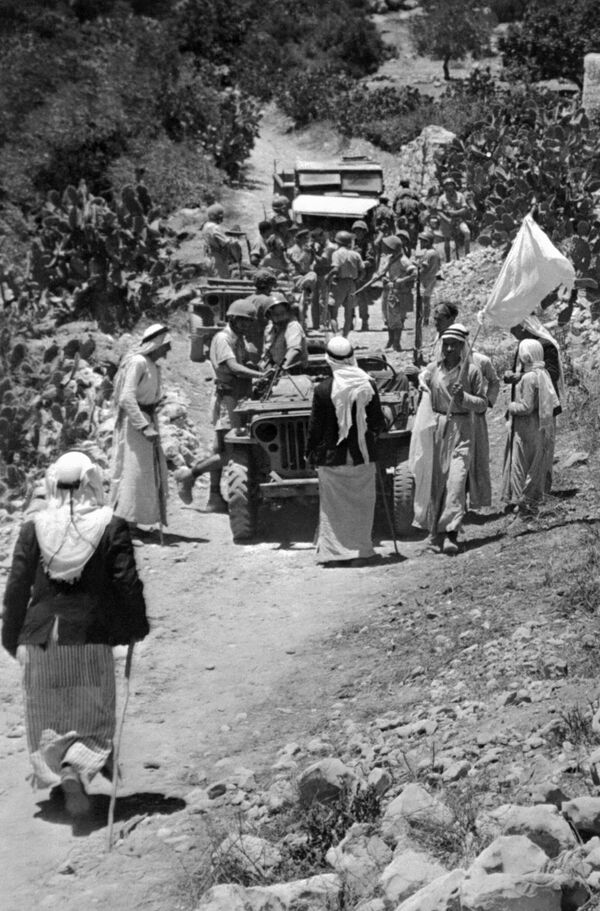
Palestinian villagers holding a white flag as they surrendered during the 1948 Arab war against the proclamation of the Israeli State. The picture was released September 15, 1948.
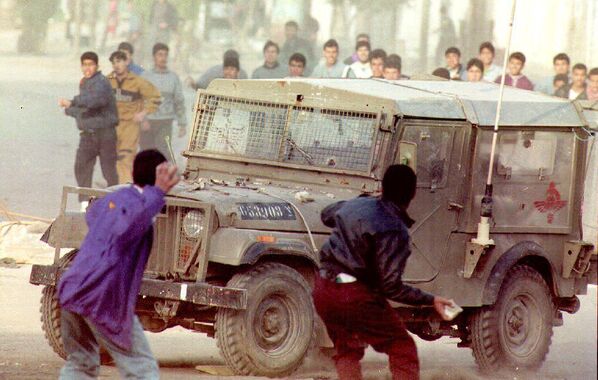
Palestinian youths hurl rocks at an Israeli army jeep during heavy clashes that erupted March 9, 1993, following the killing of an Arab worker by a settler on March 8.
During that time, the Palestine-Israel conflict was ongoing, with tensions running high in the West Bank and Gaza Strip. Israeli settlements had been established in the occupied territories, leading to friction and disputes between Israeli settlers and Palestinian residents.
The Palestinian youth threw rocks at Israeli soldiers as a form of protest and resistance against the killing of the Arab worker by an Israeli settler. Such actions were a common response to incidents of violence and perceived injustices by Israeli authorities and settlers. The throwing of stones was seen as an act of defiance and resistance to Israeli occupation.
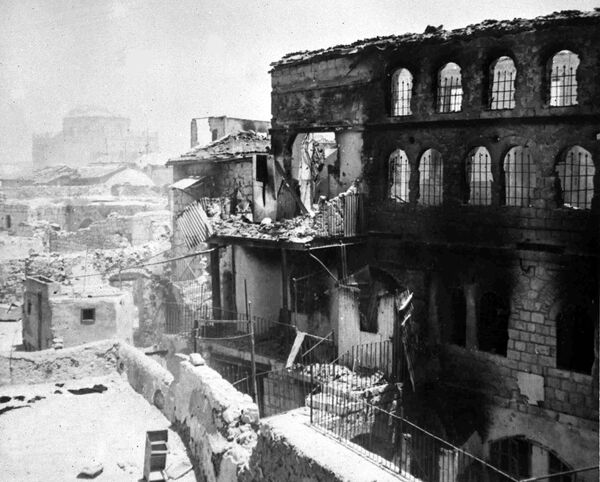
Ruins of a Jewish building in the old city of Jerusalem, Palestine, May 30, 1948, following the Arab Legion bombardment. Jewish troops surrendered themselves and the city to Transjordan Arab Legion troops on May 28.
The battle for Jerusalem was a significant part of the wider conflict, the Arab-Israeli War of 1948. Jerusalem, with its historical and religious significance to Jews, Muslims, and Christians, became a focal point of the war. The city was divided, with Jewish and Arab neighborhoods, and both sides sought control of it.
The Arab Legion, the army of the Hashemite Kingdom of Jordan, played a crucial role in the Arab forces' efforts to capture Jerusalem.
The Arab Legion, originally known as the "Arab Legion in Transjordan," was the military force of the Emirate of Transjordan, later known as the Hashemite Kingdom of Jordan. It was initially formed in the 1920s under the leadership of British officers.
The Arab Legion was commanded by British officers, including General Sir John Bagot Glubb, commonly known as "Glubb Pasha," who played a prominent role in its leadership.
The Arab Legion was one of the more organized and effective Arab military forces during the 1948 war. It received training and support from the British and played a significant role in the capture of parts of Jerusalem and the West Bank.
After the 1948 war, Jordan annexed the West Bank, including East Jerusalem, and the Arab Legion became the Jordanian Army. This annexation lasted until 1967 when Israel captured East Jerusalem and the West Bank during the Six-Day War.

Haganah fighters scale a house in June 1948 in Tel Aviv.
The Haganah was a Jewish paramilitary organization that operated in British Mandate Palestine from the early 1920s until the establishment of the State of Israel in 1948.
The Haganah, which means "Defense" in Hebrew, was founded in 1920 as a self-defense organization by Jewish residents of Palestine during the period of British rule.
The Haganah was created in response to the increasing violence and tensions between Jewish and Arab communities in Palestine during the early 20th century. The Arab riots of 1920 and 1921 highlighted the vulnerability of Jewish communities, leading to the formation of the Haganah to provide protection.
The primary goal of the Haganah was to defend Jewish communities in British Mandate Palestine against various threats, including Arab violence, as well as to prepare for the eventual establishment of a Jewish state. While its primary focus was on self-defense, it also played a role in illegal immigration and clandestine arms acquisition.
The Haganah engaged in a wide range of activities, including training its members, acquiring weapons, and establishing intelligence networks. It also cooperated with other Jewish underground organizations, such as the Irgun and Lehi, during the struggle for Jewish statehood.
With the establishment of the State of Israel in 1948, the Haganah transitioned into the Israel Defense Forces (IDF), becoming the core of Israel's military establishment. Many former Haganah members became key figures in Israel's military and political leadership.
Its legacy lives on in the history of Israel and its role in the struggle for statehood. The IDF, in essence, carries on the traditions and functions of the Haganah as the military of the State of Israel.
The Haganah played a pivotal role in the establishment of Israel and the defense of Jewish communities during a critical period in the nation's history.
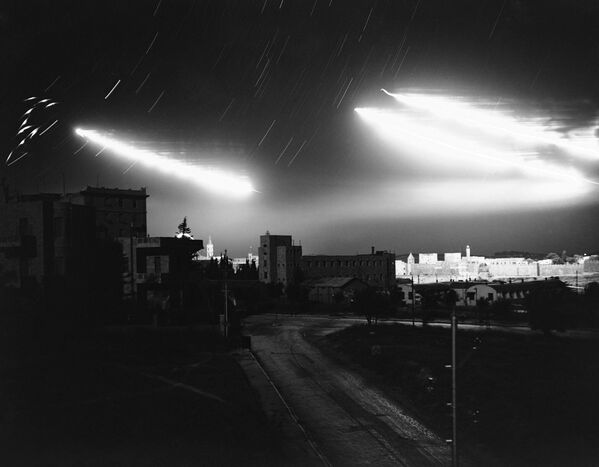
The glare from fires set by mortar and artillery shells and the flares set up by opposing fighters in the fierce battle between Arabs and Jews light up the sky above the David's Tower section of the Old City Wall of Jerusalem, held by the Arabs, July 14, 1948. It was one of the heaviest exchanges of strikes in the long struggle for the Holy City.
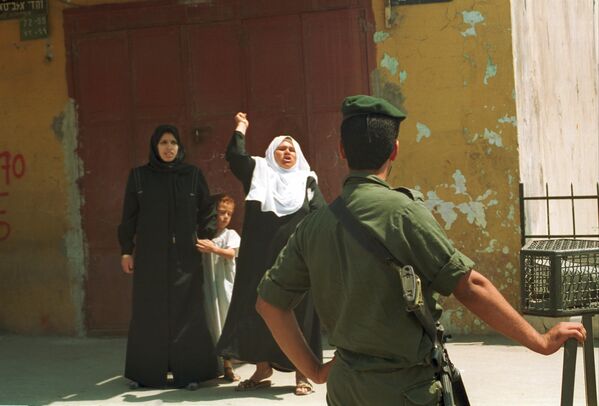
An Arab woman screams abuse at an armed Israeli border policeman after her son was arrested this morning in curfewed Gaza Strip, Occupied Gaza Strip, for hurling stones at troops, May 21, 1990.
During that time, the Gaza Strip was under Israeli military occupation as part of the broader Palestine-Israel conflict. The Israeli military had imposed curfews and various restrictions on the movement of Palestinians in the area, as part of their efforts to maintain control and security in the region.
Palestinians throwing rocks at Israeli soldiers were often during that time and were often expressions of frustration, anger, and resistance to Israeli military presence and control. The throwing of stones was seen as a symbol of Palestinian resistance, particularly among Palestinian youth.
It was common for Palestinian stone-throwers to face arrest by Israeli security forces. The response to such incidents often included arrests, detentions, and sometimes more severe measures, depending on the circumstances and the severity of the protest.
Overall, such incidents reflect the tense and challenging environment in the Gaza Strip during the period of Israeli occupation, where confrontations between Palestinian residents and Israeli forces were relatively common forms of protest and resistance.

